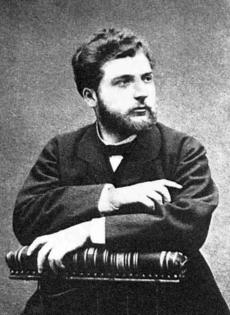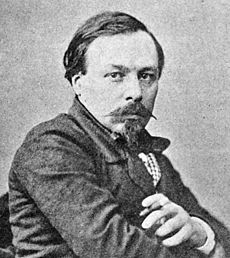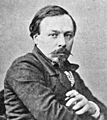Les pêcheurs de perles facts for kids
Quick facts for kids Les pêcheurs de perles |
|
|---|---|
| by Georges Bizet | |
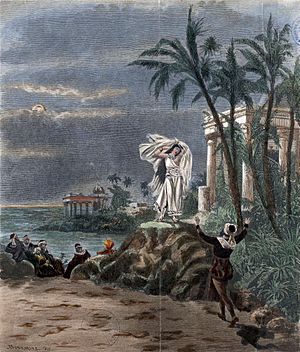
Final scene of act 1 (La Scala, 1886)
|
|
| Librettist |
|
| Language | French |
| Premiere | 30 September 1863: Théâtre Lyrique, Paris |
Les pêcheurs de perles (which means The Pearl Fishers) is an opera in three parts, called acts. It was written by the French composer Georges Bizet. The story, called a libretto, was created by Eugène Cormon and Michel Carré.
The opera was first performed on September 30, 1863, at the Théâtre Lyrique in Paris. It was shown 18 times at first. The story takes place a long time ago on the island of Ceylon (now Sri Lanka). It's about two friends whose strong bond is tested when they both fall in love with the same woman. She is a priestess who has made a special promise. The famous song "Au fond du temple saint", often called "The Pearl Fishers Duet", is one of the most well-known songs in opera.
When The Pearl Fishers first came out, Bizet was not yet 25 years old. He was still trying to make a name for himself in the music world of Paris. He got the chance to write this opera because he had won the important Prix de Rome music award. Even though people liked the opera, many critics in the newspapers didn't think it was very good. However, other composers, like Hector Berlioz, found a lot to admire in the music.
The opera wasn't performed again during Bizet's lifetime. But after 1886, it started to be shown more often in Europe and North America. Since the mid-1900s, it has become a regular part of opera house performances around the world. The original music papers (called the autograph score) were lost. So, later performances used changed versions of the music. Since the 1970s, people have worked hard to put the music back together the way Bizet first intended.
Today, music experts think more kindly of The Pearl Fishers. They say the music isn't always perfect, but it shows great promise. They see how talented Bizet was at creating beautiful melodies and using instruments in a way that creates strong feelings. Many believe it clearly shows signs of the amazing music Bizet would create later, especially his famous opera Carmen, which came out 10 years later. Since 1950, the opera has been recorded many times, in both the changed and original versions.
Contents
How the Opera Came to Be
Bizet's very first opera was a short one-act piece called Le docteur Miracle. He wrote it in 1856 when he was only 18 and studying at the Conservatoire de Paris.
Bizet won a competition organized by the famous composer Jacques Offenbach with this opera. He received money, a gold medal, and his opera was performed at the Théâtre des Bouffes-Parisiens. In 1857, Bizet won the important Prix de Rome. This award allowed him to spend three years in Italy. There, he wrote Don Procopio, a short funny opera in the style of another composer named Gaetano Donizetti.
Bizet had also written other music that wasn't for the stage, like his Symphony in C. But a religious work he wrote in Rome, called Te Deum, wasn't well received. This made him believe that his main future was in writing music for the theater. He started planning several operas before returning to Paris in 1860, but none of them were finished.
When Bizet came back to Paris, he found it hard for young, unknown composers to get their operas performed. Paris had two main opera houses that received government money: the Opéra and the Opéra-Comique. The Opéra mostly showed older works by foreign composers like Rossini and Meyerbeer. Even well-known French composers had trouble getting their music performed there. The Opéra-Comique was also slow to try new things.
However, the Opéra-Comique had a rule: sometimes they had to put on short operas by past winners of the Prix de Rome. Because of this rule, Bizet wrote La guzla de l'Emir. Rehearsals for this opera began in early 1862.
In April 1862, while La guzla was being rehearsed, Bizet was contacted by Léon Carvalho. He was the manager of a private theater company called the Théâtre Lyrique. Carvalho had been offered money by the Minister of Fine Arts, Count Walewski. The condition was that each year, he had to put on a new three-act opera by a recent Prix de Rome winner.
Carvalho thought Bizet was very talented. He offered Bizet the story for Les pêcheurs de perles. It was an exciting story by Carré and Eugène Cormon, set on the exotic island of Ceylon (now Sri Lanka). Bizet saw this as a great chance for a real success in the theater, so he accepted the job. Because the government money was only for composers who hadn't had their work performed commercially yet, Bizet quickly pulled La guzla from the Opéra-Comique. It was never performed, and its music has been lost.
Main Characters
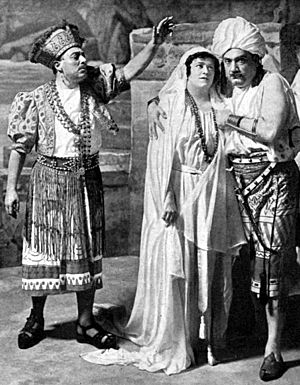
Here are the main characters in The Pearl Fishers:
| Role | Voice type | First Performed By September 30, 1863 |
|---|---|---|
| Leïla, a priestess of Brahma | soprano (a high female voice) | Léontine de Maësen |
| Nadir, a fisherman | tenor (a high male voice) | François Morini |
| Zurga, head fisherman | baritone (a middle male voice) | Ismaël |
| Nourabad, high priest of Brahma | bass (a low male voice) | Prosper Guyot |
| There is also a group of singers (a chorus) made up of fishermen, young women, and priests and priestesses. | ||
The Story of the Opera
The opera takes place in Ceylon (now Sri Lanka) a very long time ago.
Act 1: A Vow of Friendship
The first scene is on a lonely beach with old temple ruins in the background. A group of pearl fishermen sing about the dangers of their work. They also do special dances to scare away bad spirits. Then, they choose one of their own, Zurga, to be their leader or "king."
Nadir arrives, and Zurga greets him as a long-lost friend. When they are alone, the two friends remember their past in the city of Kandy. Their friendship was almost ruined there because they both fell in love with a young priestess whose beauty they had only seen for a moment. They both promised to give up their love for this stranger and stay true to each other. Now that they are together again, they promise once more to be loyal friends until they die. This is when they sing the famous "Au fond du temple saint" duet.
A boat comes to the beach carrying Leila. She is a priestess whose prayers are needed to keep the fishermen safe. Neither Nadir nor Zurga recognizes her, but she is the same woman from Kandy they both loved. Zurga explains her duties. Leila recognizes Nadir, but she doesn't say anything. Soon after, the high priest Nourabad leads her to the temple. Zurga and the fishermen go to the sea, leaving Nadir alone.
Nadir thinks about how he broke his promise to Zurga in Kandy by secretly loving the veiled woman. He sings about this in his song "Je crois entendre encore". He came to this place because he heard she might be here. Alone in the temple, Leila prays and sings. Nadir wakes up and recognizes the voice of the woman he loves. He finds her at the temple. Leila briefly lifts her veil, and he sees it is her. They both declare their renewed love for each other. On the beach, the fishermen ask her to keep protecting them. But she tells Nadir she will sing only for him.
Act 2: A Broken Promise
Inside the temple with Nourabad, Leila feels scared about being left alone. But Nourabad tells her to be brave and keep her promises to Brahma, or she will die. She tells him how brave she was as a child. She once hid a person from their enemies and refused to give them up, even when threatened with death. The person she saved gave her a necklace and asked her to always wear it. She has kept that promise, just as she will keep her vows. After the priest leaves, Leila quietly thinks about the times she and Nadir used to meet secretly.
Then Nadir enters. Leila is scared of Nourabad's threats and begs him to leave. But he stays, and they both declare their love in a passionate song. Nadir leaves, promising to come back the next night. But as he goes, the fishermen catch him and bring him back to the temple.
Zurga, as the leader, at first tries to stop the fishermen from killing Nadir. He wants to show mercy. However, after Nourabad removes Leila's veil, Zurga realizes she is the woman he also loved. Filled with jealousy and anger, he orders that both Nadir and Leila be put to death. A big storm starts, and the fishermen sing a hymn to Brahma.
Act 3: A Sacrifice for Love
In his tent on the beach, Zurga notices the storm has stopped, and his anger has also calmed down. He now feels bad about being so angry with Nadir. Leila is brought in. Zurga is amazed by her beauty as he listens to her beg for Nadir's life. But his jealousy returns. He tells her he loves her, but he refuses to show mercy. Nourabad and some fishermen come in to say that the fire for their execution is ready.
As Leila is taken away, Zurga sees her give her necklace to one of the fishermen. She asks him to return it to her mother. With a shout, Zurga runs after the group and grabs the necklace.
Outside the temple, Nadir waits by the fire. The crowd sings and dances, waiting for the sun to rise and the double execution. Leila joins him. Now accepting their deaths, they sing about how their souls will soon be together in heaven. A light appears in the sky, and Zurga rushes in to say that the fishermen's camp is on fire. As the men hurry to save their homes, Zurga frees Leila and Nadir. He gives the necklace back to Leila. He then tells her that he is the man she saved when she was a child. He realizes that his love for her is hopeless. He tells her and Nadir to run away. As the couple leaves, singing about the loving life that awaits them, Zurga is left alone to wait for the fishermen to return.
In some later versions of the opera's ending, Nourabad sees Zurga freeing the prisoners. He tells the fishermen, and one of them stabs Zurga to death as Leila and Nadir's farewell song ends. In other versions, Zurga dies in different ways, and his body is put on the fire.
Writing the Music and Story
The story (libretto) for The Pearl Fishers was written by Eugène Cormon and Michel Carré. Cormon wrote many stories for operas and plays, often with other writers. Carré, who first trained as a painter, had worked on the story for Gounod's opera Faust. He also helped write a play that became the story for Offenbach's opera The Tales of Hoffmann.
Before The Pearl Fishers, Cormon and Carré had written a similar story for another composer, Aimé Maillart. That opera was called Les pêcheurs de Catane and was performed in 1860. They had first planned to set their new story in Mexico before changing the location to Ceylon.
Many critics agree that the story of The Pearl Fishers is not very strong. Bizet's biographer, Winton Dean, pointed out that the plot relies on a very unlikely coincidence about Leila's necklace. He also said that the characters don't feel very real. Mina Curtiss, who wrote a book about Bizet, called the story boring and unoriginal. Donal Henahan of The New York Times said in 1986 that the story was "appallingly inept" (terribly clumsy).
The writers themselves knew the story had problems. Cormon later said that if they had known how good Bizet was as a composer, they would have tried harder. Carré was worried about the weak ending and kept asking for ideas to change it. Curtiss wrote that the theater manager, Carvalho, jokingly suggested that Carré burn the story. Curtiss believes this joke led Carré to end the opera with the fishermen's tents on fire as Leila and Nadir escape.
Bizet had to compose the music very quickly. He didn't get Carvalho's request until April 1863, and the opera was supposed to open in mid-September. Curtiss said he worked with "a tenacity and concentration quite foreign to him." He did have some music he had already written that he could use. For example, he had worked on an opera called Ivan IV the previous winter. Music from Ivan IV was used for three parts of Les pêcheurs de perles: the opening music (prelude), part of Zurga's song, and a duet in the third act. The chorus "Brahma divin Brahma" came from his rejected Te Deum. It's also likely that music from his cancelled opera La guzla de l'émir was used. Bizet finished the music by early August. The story was changed often, even during rehearsals. Some songs were added, and others were shortened or removed.
The Music of the Opera
The opera starts with a short orchestral piece called a prelude. Its main tune hints at Leila's entrance later. The opening song by the chorus is lively and exciting. Nadir's first important song, "Des savanes et des forêts", is sung with cellos and bassoons playing a trembling sound. This might show the influence of composer Meyerbeer.
Flutes and harps introduce the main tune of the famous "Pearl Fishers Duet." This duet is seen as one of the most poetic parts of the opera. The duet's tune has become the opera's main musical theme. It is repeated whenever the friendship between the two men is important. However, some critics, like Winton Dean, think the tune isn't strong enough for how often it's used. Dean believes Bizet's skill at finding the right music is better shown in how he handles Leila's promise of purity. There, a simple tune is repeated twice with small changes. Nadir's song "Je crois entendre encore," near the end of Act 1, has a gentle, rocking rhythm, like a boat song. A special instrument called a cor anglais plays the main melody, making it sound like a horn is singing.
In Act 2, a short orchestral introduction is followed by a chorus singing from off-stage. This part is special because it has very few instruments playing—just a tambourine and two piccolos. After Nourabad reminds Leila of her promise and leaves her alone, she sings her beautiful song "Comme autrefois". Two French horns introduce the tune, supported by cellos. When Leila's voice comes in, it seems to continue the sound of the first horn. Dean compares this song to a famous song from Bizet's later opera Carmen. Nadir's song "De mon amie," which follows Leila's, has a "haunting beauty." Its opening tune reminds some of an oboe theme from Bizet's early Symphony in C. Dean points to the end of Act 2, with its repeated exciting moments as the crowds demand the couple's deaths, as an example of Bizet's growing skill in writing music for the theater.
Act 3, which has two short scenes, begins with Zurga's entrance. The music here uses quiet, rising and falling notes over a steady low note. Bizet would use this effect again later in his music for the play L'Arlésienne. The duet "Je frémis" has clear hints of Verdi's opera Il trovatore. The fiery chorus "Dès que le soleil" sounds a bit like a fast, light piece by Mendelssohn. But other parts of the final act's music are considered weaker and less dramatic. In the very last scene, when Zurga says goodbye to his dreams of love, the friendship tune from the Act 1 duet plays one last time.
Experts say Les pêcheurs de perles is typical of French opéra lyrique, a style of opera. This is seen in Bizet's use of singing that is like talking (arioso) and dramatic talking parts (recitative), how he creates different moods, and how he makes the music sound exotic. Berlioz said the opera's music was beautiful, expressive, colorful, and full of energy. However, Bizet himself didn't think highly of the work. He felt that, except for a few songs, it should be forgotten.
Critics in Paris at the time were used to softer music. They complained that Bizet's music was too loud, too heavy, and sounded too much like the German composer Wagner. One called it "a fortissimo in three acts" (meaning it was loud for three whole acts). The conductor Hans von Bülow called it a "tragical operetta" in a disrespectful way. Modern writers are usually kinder to the opera. They say the music might not be perfect everywhere, but it shows interesting hints of Bizet's later, more famous works. Others praise Bizet for overcoming the weak story with some truly dramatic moments and inspiring melodies.
Recordings of the Opera
The first full recordings of The Pearl Fishers came out in the early 1950s. Before that, many individual songs from the opera had been recorded. The duet "Au fond du temple saint", sung in Italian by Caruso and Mario Ancona, was recorded as early as 1907.
The 1977 recording by Georges Prêtre was the first complete version based on Bizet's original 1863 music. The 1989 version by Michel Plasson used the 1863 music but gave listeners two versions of the famous duet: the shorter original one and the longer, more popular one. A shorter version conducted by Brad Cohen, sung in English, also includes both versions of the duet.
Images for kids
See also
 In Spanish: Los pescadores de perlas para niños
In Spanish: Los pescadores de perlas para niños


